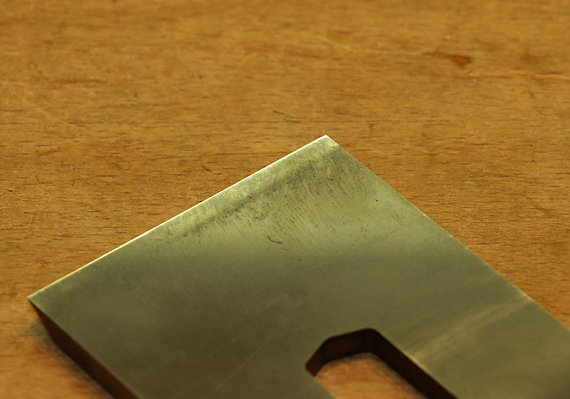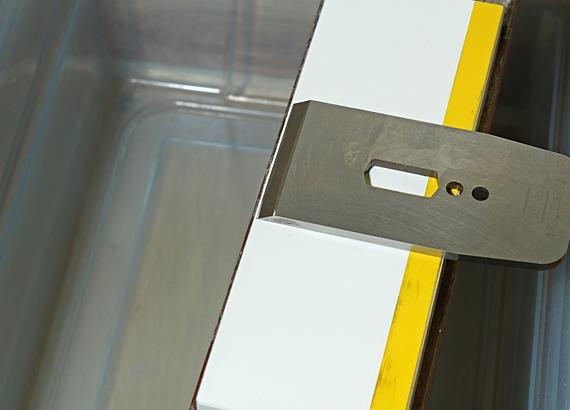
The late David Charlesworth’s “Ruler Trick” is a wonderfully efficient addition to your sharpening methodology. For those unfamiliar with it, please see his short video – it is easier to appreciate than a verbal description. It basically is a simple way to hone the steel only just behind the cutting edge on the flat side of a plane blade without having to work the entire flat side. The resultant tiny bevel is only about 1/2°. (See the thin bright line in the photo above.) Thus, you create two meeting surfaces of finely honed steel to make a sharp edge.
It is often promoted primarily as way of efficiently commissioning a new blade. The “trick” is that you do not have to flatten the entire back or any sizable area of it, just that thin strip near the edge. For that alone, it is invaluable but it is even more useful in subsequent sharpenings to remove the wear bevel.
Here I must credit Brent Beach and his incredibly extensive and informative website. The “wear bevel,” simply put, is the rounded wearing of the top and bottom of the blade just behind the apex of the cutting edge. For both bevel-up and bevel-down planes, as the lower wear bevel develops, it requires you to push down harder on the plane to get it to cut. As the wear progresses, you sense the plane blade getting more dull. Notably, the lower wear bevel is greater for higher bevel-side honing angles in bevel-up planes, which are often used to reduce tear out.
When we sharpen the bevel side of the blade in bevel-down planes, we are rectifying that lower wear bevel. We remake two clean surfaces meet and reestablish the clearance angle just behind the edge apex.

A particular problem comes in bevel-up planes. That lower wear bevel is only addressed inasmuch as you effectively work on the flat side steel just behind the edge apex. If you do not fix the flat side, you have not effectively prepared the blade for work.
The practical reality is that it takes too much work to remove a layer of metal, albeit quite thin, over the whole back of the blade to remove the wear bevel on that side. Enter the Ruler Trick. It does it quick and easy. Brent Beach describes a steeper, more complicated “back bevel” but I think the Ruler Trick is a good compromise in practice, though I cannot quantify this.
So, here is my point: while the Ruler Trick is very helpful for sharpening bevel-down plane blades, it is, as a practical matter, essential for sharpening bevel-up plane blades. Note too, that many specialty planes are also bevel-up, such as shoulder planes and router planes. They need the Ruler Trick too.
Next: What about chisels?


I have known about Charlesworth’s ruler trick for about 20 years, but studying Beach’s website a few years back was what finally convinced me to the core that it’s the way to go. In at least one interview (Popular Woodworking) and in conversation with me, Toshio Odate has called the ruler trick “stupid.” But then, the ruler trick is built into the hollow backs of Japanese plane irons. And the occasional tapping out of the iron required to maintain the hollow of a Japanese plane iron is a skill unto itself, which is far harder (and riskier) to learn than the ruler trick.
Thanks, Jim. I agree on all counts.
Rob
I don’t often apply the Ruler Trick to undamaged bevel up blades, but when restoring planes I find it comes in handy to salvage an older worn blade. On my first attempt I was a bit hesitant and decided that maybe I would want to reverse my efforts and so I selected a thinner piece of shim stock, .008″ i believe to give me a smaller back bevel. I guess I should have paid more attention in Trig and geometry classes as the back bevel becomes the hypotenuse of the triangle and it was longer as a result. In any event it worked out and I use the trick on restorations as required. Moral of this story is don’t use too thin of a blade for adding the back bevel.
I also note that some plane blades I come across have a significant dubbing of the back surface from poor sharpening techniques or worn stones i suspect. I have decided that it is not worth my time and effort to flatten the back to correct this. If it does not extend too far along the back of the blade I grind away the affected area. I doubt this will compromise the life of the blade in my lifetime and I can get back to woodworking. In extreme cases I have replaced the blade.
Dan,
I think the .020″ shim or ruler works out to be a decent compromise between what you noticed – a bevel that is too long and too shallow – and a bevel that is to thin to quickly get past the wear bevel. At least that’s what I’ve found in practice.
Brent Beach, on his website, does address the ruler trick, and figures that, as described by David Charlesworth, it should be enough to eliminate the wear bevel as he has measured it. He intended to do actual testing but I cannot find it on his site and perhaps he never got around to it. If anyone has found it, I would appreciate a link to it.
Anyway, the regular ruler or .020″ shim seems to work for me and I’m happy with that.
As for dubbed-over new blades as you described, yes, what a menace. I would return them to the seller.
Rob
I think this whole thing starts with the wrong premise that you sharpen until the wear bevel is gone on the side you’re sharpening. One needs to continue past that, removing material until the side you’re working intersects with the back face… that is when you’re done. In practical terms, that really doesn’t take long if the top bevel is a micro bevel (which is still far larger than the worn edge).
Another aspect of the back bevel is that you’re actually reducing the durability of the cutting edge by reducing material behind it. That to me is the real downside of the bevel up plane versus a traditional bevel down. There is an increase in the clearance angle, reducing the support behind the cutting edge, and there is no way to accommodate it.
Sam, I think we have a different understanding of the sharpening process and the geometry of plane setup but I certainly appreciate your adding another point of view.
Rob